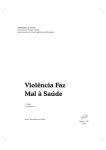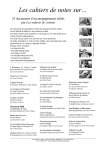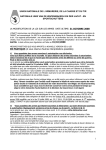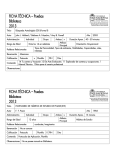Download BIBLIOGRÁFIA DE LAS ALTAS CAPACIDADES
Transcript
BIBLIOGRÁFIA DE LAS ALTAS CAPACIDADES A ACEREDA, AMPARO. “Niños Superdotados” Ediciones Pirámide. ACKERMAN, J.M.. The promise to learn. Written comunication, 10(3), 334-370 ADDA, ARIELLE Y HELENE CATROUX – “Niños Superdotados, la Inteligencia Reconciliada”. Paidós AFIFI, A. K. Y BERGMAN, R. A.: “Neuroanatomía funcional.” México, McGraw- Hill Interamericana. ALBERT, R.S. (Ed.) "Genius and eminence". En International series in experimental total psychology, Vol.22.Oxford, England: Pergamon Press. Inc. ALLAL, L.; CARDINET, J. ; PERRENOULD, Ph. "L'evaluation formative dans un enseigment differencié". Peter Lang. Berne. ALLPORT, G. W. ” Psicología de la Personalidad” Paidós. Buenos Aires. ALONSO, J.. Orientación educativa: teoría, evaluación e intervención. Madrid: ALONSO, C., GALLEGO, D., HONEY, P. “Los estilos de aprendizaje”. Ediciones Mensajero. Bilbao. ALONSO, J.A. Y BENITO, Y. “Superdotados: adaptación escolar y social en Secundaria”. Madrid: Narcea. Madrid ÁLVAREZ, M. Y OTROS. “Manual de orientación y tutoría”. Praxis. Barcelona. ALTMANN, G.T.M. “Cognitive models of speech processing”. Cambridge, MIT Press. ALLGOOD, W.P., RISKO,V. J.,ÁLVAREZ, M.C. Y FAIRBANKS m.m. “Factors that influence study”. En R.F. Flippo y D.C. Caverly (Coord.), Handbook of collage reading and study strategy research, (pp.201-219) NJ:llea AMIDON, S.R. (1991). "Encouraging higher level thinking in the gifted adolescent". En Bireley, M. Y Gehshaft J. Eds. Understanding the gifted adolescent: Educational, developmental, and multicultural issues. ANDREANI, O., ORIO, S. (1978): “Las raíces psicológicas del talento: investigaciones acerca de la inteligencia y de la creatividad”. Buenos Aires, Kapeluz ANIM, N. (1992). "Gifted and talented in the Third World". En Mönks, F.J. y Peters, W.A.M. Eds. Talent for the future: Social and personality devenlopment of gifted children: Proceedings of the Ninth World Conference on Gifted and Talent Children. Assen: Van Gorcum & CO B.V. ANTUNES CELSO –“Estimular las Inteligencias Múltiples” Narcea. AMESTOY DE SÁNCHEZ, M. (1993): “Desarrollo de habilidades de pensamiento”. México, D.F., Trillas. ALPERS, B.J. (1952): “Neurología clínica” México, Interamericana. . ARISTÓTELES (2000): “De Ánima”. Madrid, Editorial Credos. ARISTÓTELES (2000): Ética a Nicómaco. Madrid, Editorial Credos. ARMSTRONG, T. (1987). In their own way: Discovering and encouraging your child's personal learning style. Los Angeles: Jeremy P. Tarcher, Inc. ARNOLD, K.D. (1994). "The Illinois Valedictorian Project: Early adult careers of academically talented male high school students". En Subotnik R.F. Y Arnold K.D., Eds. Beyond Terman: Contemporany longitudinal studies of giftedness and talent. Creativity research. Norwood ARNOLD, K.D., NOBLE, K.D. Y SUBOTNIK, R.F. (Eds.) Remarkable women: Perspectives on female talent development Cresskill, Nueva Jersey: Hampton Press, Inc AROCAS SÁNCHEZ, E.”La respuesta educativa a los alumnos superdotados y/o con talentos específicos”. Valencia: Generalitat, Consellería Educació i ciencia. B BACTO, M. Y OTROS.. "The gifted and talent". En Schwenn, J.O., BALAGUÉ I BELTRÁN, M.P. “Superdotació i Talent. Estratègies docents per a l'atenció a la diversitat dels alumnes superdotats i dels alumnes talentosos a l'ensenyament secundari obligatori”. Proyecto. BALDWIN, A.Y. (1985). "Programs for the gifted and talented. Issues concerning minority populations". En Horowitz, F.D. y O'Brien, M. Eds. The gifted and talented: Developmental perspectives. Washington, DC: American Psychological Association. (pp.223-249). BANDURA, A. (1993). Perceived self-efficacy in cognitive development and functioning. Educatíonal Psychologist, 28(2), 117-148. BARÓN, REBEE Y WACELE, ELIZABETH “El Eneagrama, claves para las Relaciones Perfectas” Ed. Martínez Roca BEAR, M.F., CONNORS, B. W., “Neurociencia: Explorando el Cerebro”. Paradiso, M.A. Masson –Wiliams & Wilkins. Barcelona. BEAUDOT, ALAIN (1980): “La creatividad” Narcea., Madrid. BOADFORD, H.F.“Fundamentos de Neuroquimica”. , Labor. Barcelona, BENBOW, C.P Y LUBINSKI, D. (1993). "Psychological profiles of the mathematically talented: Some sex differences and evidence supporting their biological basis". En The origins and development of high ability. Ciba Foundation sysmposium, nº 178. Chichester. england JOHN WILEY & SONS. (pp.44-66). BENEJAM, P. Y PAGÉS, J. (coord.). (1997). “Ciencias Sociales. Guías Praxis para el Profesorado. Contenidos, Actividades y Recursos”. Praxis. Barcelona. BENITO, Y. (1990). “Problemática del niño suprerdotado”. Amarú. Salamanca: BENITO, Y. (1994). “Intervención e investigación psicoeducativas en alumnos superdotados”. Amarú. Salamanca. BENITO, Y. (coord.) (1992). “Desarrollo y educación de los niños superdotados” Amarú. Salamanca. BENITO, Y. Y MORO, J. (1997). “Proyecto de Identificación Temprana de Alumnos Superdotados”. MEC. Madrid. BISQUERRA, R. (1997). "Para saber más". En Cuadernos de Pedagogía, nº 259 Junio 1997. BLANCO PRIETO, F. (1994). “La evaluación en la educación secundaria”. Amarú. Salamanca: BOLÍVAR, A. (1995).”La evaluación de valores y actitudes”.Anaya/Alauda. Madrid. . BLUMENFELD, P.C. Y MARX, R.W. (1997). “Motivation and cognition”. En HJ. Waiberg and G.D. Haertel (Eds.), Psychology and educational practico (pp. 79-100). Berkeley, CA: McCutehan Publishers. BLOMM, F.E Y LAZERSON,A. (1988): brain, mina and behavior. Ney York, Freeman & Co. BOWLBY, J. “El Vínculo Afectivo”. Paidós. Buenos Aires, Argentina. BOWLBY, J. “Una Base Segura”. , Paidós. Buenos Aires. Argentina. H. F. BOWLBY, J ”Fundamentos de Neuroquímica”.Labor. Barcelona. BONO, EDWARD DE (1996). “Lógica Fluida”. Praxis. Barcelona. BORNSTEIN. M-H. (Ed.) (1995). Handbook of parenting, Vol.1: Children and parenting. Mahwah, Nueva Jersey: Lawrence Erlbaum Associates. Inc. BRAILOWSKY, S., STEIN, B. W. (1992): El cerebro averiado. México, FCE BRALIC, S., ROMAGNOLI, C. (2000): Niños y jóvenes con talento, una educación de calidad para todos. Santiago de Chile, Domen Ediciones BRODY, L.E. Y OTROS. (1994). "Gender differences among talented adolescents: Reserach studies by SMPY and CTY at the Johns Hopkins University". En HELLER, K.A. Y HANY, E.A. Eds. Competence and responsibility, Vol.2. Gottingen, Alemania: HOGREFE & HUBER PUBLISHERS (pp.204-210). BUZAN, T. Y BUZAN, B. (1996): “El libro de los mapas mentales”. Urano. Barcelona. BUNGE, M “El problema mente-cerebro. Un enfoque psicobiológico”. Madrid, BUCHANAN, N.K. Y FELDHUSEN, J.F.. “Conducting research and evaluation in gifted education”: A handbook of methods and aplications: TEACHERS COLLEGE PRESS. Nueva Cork C CALHOUN, C., SOLOMON, R. : ¿Qué es una emoción?. México, FCE CAPELLETTI, A. (1994): “Mitología y filosofía en los presocráticos”. Cincel. Madrid. CCASTELLO I TARRIDA, A. “Inteligencia artificial y artificios intelectuales” [microforma]; tesis doctoral dirigida por Càndid Genovard i Rosselló. ISBN 84-7488428-4 [UAB UB UdL URV] CARLSON, N.R. (1999): “Fisiología de la Conducta”. Ariel. Barcelona. CARLSON, N.R. “Fundamentos de Psicología Fisiológica”. Prenüce Hall. México. CASTELLÓ I TARRIDA, A. "Concepto de superdotación y modelos de inteligencia" en: “Desarrollo y educación de los niños superdotados”; Yolanda Benito Mate (Coord.) Salamanca: Amarú, 1992. 417 p. (Ciencias de la educación (Amarú) Salamanca. ISBN 84-86368-61-8 [UAB UB UdL URV] CÁRTER, R. “El Nuevo Mapa del cerebro”. Integral. CHALVIN, M.J.: “Los dos cerebros en el aula”, Ediciones TEA. Madrid. CASTELLO ANTONI Y MARTINEZ, MERCE “Alumnado Excepcionalmente Intelectualmente”. Departamento de Educación. Generalitat de Catalunya, España CASTELLÓ I TARRIDA, A. "Estrategias de enrequecimiento del currículum para alumnos y alumnas superdotados" a: Aula de innovación educativa, 1995, 45: p. 1926. [BC UAB UB UdG UdL UJI UOC UPC UPF Uvic] CASTELLÓ I TARRIDA, A. "La integración del alumno superdotado" a: Monereo i Font, Carles. Areas de intervención del psicólogo de la educación en la integración escolar del alumno con necesidades educativas excepcionales. Barcelona: Federación Ecom, DL 1987. 169 p. [UB UdL UPC UVic] CASTELLÓ I TARRIDA, A. "La inteligencia humana" a: Intervención e investigación psicoeducativas en alumnos superdotados; [coordinadora: Yolanda Benito Mate; autores: Juan A. Alonso Bravo] Amarú. Salamanca (CC de la educación; 32) ISBN 8486386-96-0 [UB UdL UJI URV] CASTELLÓ I TARRIDA, A. "Panorama de la educación cognitiva en niños superdotados" Congreso Internacional sobre Educación Cognitiva (1995: Zaragoza). Educación cognitiva; Santiago Molina García, Manuel Fandos Igado (coords.); Anés Vela, Jesús L. [et al.]. Zaragoza: Mira, DL 1996. 2 v. 351, 303 p. ISBN 84-88688-10-5 [UB UJI UdL] CASTELLÓ I TARRIDA, A.; Genovard Rosselló, C. “El límite superior: aspectos psicopedagógicos de la excepcionalidad intelectual”. Pirámide. Madrid ISBN 84-3680528-3 [UAB UdG UdL UJI UOC URV Uvic] CASTELLÓ, A. (1995) "Estrategias de enriquecimiento del currículum para alumnos y alumnas superdotados". En Aula, nº 45 (pp. 19-26). CENTRO DE RECURSOS DE EDUCACIÓN ESPECIAL DE NAVARRA – C.R.E.E.N.A. Orientaciones para padres de niños y jóvenes con altas capacidades. Gobierno de Navarra. Departamento de Educación y Cultura. CERDÁ MARÍN, C. (1990). “Niños con necesidades educativas especiales. Bases conceptuales, diagnostico y tratamiento”. Promolibro. Valencia:. CRICK, F: “The Astonishing Hypothesis. The Scientific searchfor the soul”, Editorial Touchstone. New Cork CRICK, F. (1994): “La búsqueda científica del alma. Una revolucionaría hipótesis para el siglo XXI”. Debate. Madrid. COCHRAN-SMITH, M. “Learning and unlearning: The education of teacher educators”. Teaching and Teacher Education 19(1), 5-28. COHN, D. “Transparent Minas”. Harvard University Press, Cambridge. COLL, C. S. (1990): “Aprendizaje escolar y construcción del conocimiento” Paidós. Buenos Aires. COHEN, L.M. Y AMBROSE. D.C. (1993). "Theories and practices for differentiated education for the gifted and talented". En Heller K.A. y otros (Eds.). Internationa handbook of research and development of giftedness and talent. Oxford, Reino Unido: PERGAMON PRESS, INC. (pp. 339-363). CORIAT, A.R. “Los teórico”.Herder.Barcelona. niños superdotados. Enfoque psicodinámico y CONFREY, J., CASTRO-FILHO, J., Y WILHELM, J. (2000). “Imple-mentation research as a means to link systemic reform and applied psychology in mathematics education”, Educational Psydnlogist, 35 (3), 179-191. CONDEMARÍN, M. Y CHADWICK, M. (1986): “La escritura creativa y formal”. Editorial Andrés Bello. Santiago de Chile CONDEMARÍN, M.: “Lectura Temprana”. Editorial Andrés Bello. Santiago de Chile. CONDEMARÍN, M. “Lectura Correctiva y Remedial”. Ed.Andrés Bello. Santiago de Chile, CORNO, L. “The best-laid plans: Modern concep-tions of volítion and educational Research” Educational Researcher, 22, 14-22. ·CROONBACH, LEE J. “Essentials ofpsychological testing”. 5th ed. Harper Collins, cop. 1990 XXVI, 726 p. ISBN 0-06-04148-9. New York EDICIONES S.M. COSTA, A. (1991): Developing Minds. Association for Supervisión and Curriculum COSTA, A. (1991): “Developing Minds. Association for Supervisión and Curriculum” Ediciones SM. Madrid. CSIKSZENTMIHALYI, M. Y CSIKSZENTMIHALYI, I.S. (1993). "Family influences on the development of giftedness". En The origins and development of high ability. Civa Foundation Symposium, 178. Chichester, Inglaterra: JOHN WILEY & SONS. (pp. 187206). CYRULNIK, B.: “La maravilla del dolor”. Editorial Granica Barcelona. CYRULNIK, B. “Los patitos feos. La resiliencia: una infancia infeliz no determina la vida” Gedisa. Madrid. D DAMASIO, A. ” El error de Descartes”. Ed. Grijalbo-Mondadori. Barcelona DAVIES-BLACK. NAUTA, W. HJ. Y FEIRTAG, M. “Fundamentos de Neuroanatomía”. Lavir.Nickelson R,.PERQUINS. Barcelona. DE BONO, E. “El pensamiento práctico”. Paidós. Barcelona. DE BONO, E. “Más allá de la competencia” Paidós. Barcelona. DE BONO, E. : “Cómo enseñar a pensar a tu hijo”. ,Paidós. Barcelona. DE BONO, E. (1994): “La revolución positiva”. Paidós. Barcelona. DE LA TORRE, S. (1991). “Evaluación de la creatividad” Escuela Española. Madrid: DE LA TORRE, S. (1995). “Creatividad aplicada” Escuela Española. Madrid. DELGADO, J. (1994):”Mi cerebro y yo”. Ediciones Temas de Hoy. Madrid DELGADO, J. (1988): “La felicidad”. Ed. Temas de Hoy, Colección Fin de Siglo. Mdrid. DENNETT, D.C. (1991): Consciousness Explained. Litde Brown..Boston. DE MIRANDÉS, JOSÉ Y TIERNO, BERNABÉ. La Educación Inteligente. – Temas de Hoy. Madrid. DEVELOPMENT. VIRGINIA U.S.A. CÓRDOVA, A., HECHT, K. “El problema del estrés en la medicina”. Editorial Científico-Técnica. .La Habana. DEWEY,J. (1989): “Cómo pensamos. Nueva exposición de la relación entre pensamiento reflexivo y proceso educativo” Paidós. Barcelona. DÍAZ AGUADO, M. J. Y MEDRANO, C. “Educación y razonamiento moral. Bilbao”: Mensajero Bilbao. DÍAZ, O.; PÉREZ, L. y DOMÍNGUEZ, P. "El desarrollo de los más capaces". Ministerio de Educación y Cultura. Madrid. DIAMOND, M. C., SCHEIBEL, A. B. Y ELSON, L. M. (1996): “El Cerebro Humano: Libro de Trabajo” Ariel. Barcelona. DOVAL, L. Y CAJIDEVAL, J.."Superdotación: evaluación o diagnóstico". En Revista de Ciencias de la Educación, nº162 (pp. 191-213). : Instituto Calasanz de Ciencias de la Educación. Madrid DOUGLAS, M. (1998): Estilos de pensar. Editorial Gedisa. Barcelona. DURDEN, W. G. Y TANGHERLIN, A. E. “Smart Kids. How academic talents are developed and nutured in America.” Hogrefe & Huber Publishers. Toronto.. E ESCUELA ESPAÑOLA. (1998). "El Gobierno Británico potenciará las escuelas para alumnos superdotados" en Escuela Española, nº3377. Madrid. ENTWISTLE, N. J., Y TAIT, H. “Promoting effective study skills” Module 8, Block A. of Effective Learning and Teaching in Higher Education. Sheffield: Universi-ties' and Colleges' Staff Development Agency EYSENCK, H.J. “Estructura y medición de la inteligencia” con aportaciones David W. Fulker. Barcelona: Herder Barcelona. [Traducción de: The structure and measurement of intelligence, Berlin [etc.]: Springer, 1979]. ISBN 84-254-1251-X [UB UdG UdL URV] F FELDHUSEN, J. F. "Eclecticism: A Comprehensive Aproach to Education for the gifted" (pp. 192-204). FERRRANDIS, A. “La escuela comprensiva”.: M.E.C.: C.I.D.E. Madrid. FREEMAN, J. “Los niños superdotados. Aspectos psicológicos y pedagógicos”.Santillana Madrid. FLARIS, S. G., Y PARÍS, A. H. (2001). “Classroom applica-tion of research on selfregulated learning”. Educational Psychologist, 36(2), 89-101. FREENSTA, COKS. El Niño Superdotado, Ediciones Médici. Barcelona. G GARCÍA GANUZA, J. M. Y ABAURREA, V.. “Alumnado con Sobredotación Intelectual – Altas Capacidades”. Gobierno de Navarra. Departamento de Educación y Cultura. Navarra (en español y euskera). GARCÍA YAGÜE, E.(1986). "El niño bien dotado y sus problemas". CEPE Colección Educación Especial. Madrid. GARCÍA, N. Y GONZÁLEZ, D. (1992). “Evaluación e informe psicopedagógico”. E.O.S. Madrid. GARCÍA-ALCAÑIZ, E. E. IZQUIERDO, A. (1995). "Conceptualización y modelos en la superdotación", en Revista de Ciencias de la Educación, nº162 (pp. 149-161).Instituto Calasanz de Ciencias de la Educación. Madrid: GARDNER. H. (1993): “La mente no Escolarizada”. Paidós. Barcelona. GARDNER, H. (1995).”Inteligencias múltiples”. Paidós. Barcelona. GARNHAM. A. Y OAKHILI. J. (1996): “Manual de Psicología del pensamiento”. Paidós. Buenos Aires. GARRIDO, ISAAC . – Psicología de la Emoción. Síntesis. Madrid GARRIDO, ISAAC . – Psicología de la Motivación. Síntesis. Madrid GAZZANIGA . M.“The bisected brain”. Nueva Cork, Appleton . GAZZANIGA . M. S. “Mind Matters. How Mind and Brain” Interact to Create our conscious lives. Houghton Mifflin. Boston. GAZZANIGA . M.S. “El Cerebro Social”. Alianza Editorial. Madrid GENOVARD, C. "Educación especial para profesores de educación especial de niños excepcionales superdotados: inventando el futuro": Educar: revista de la Secció de Ciències de l'Educació de la Universitat Autònoma de Barcelona, 1983, 4: p. 101-109 [BC UAB UB UdG UdL UPC URV Uvic] GENOVARD, C. Y CASTELLÓ, A. (1990). “El límite superior. Aspectos psicopedagógicos de la excepcionalidad intelectual”. Ediciones Pirámide. Madrid.. GEMELLI. A. Y ZUNINI. G. (1968): “Introducción a la psicología”. Miracle. Barcelona. GROSS C. G.: “Neurogenesis in the adult brain”: death of a dogma. Nat. Rev. Neurosci. 2000, 1:67. GÓMEZ, A. ; RODRÍGUEZ, R.I. "Talento" : 10 palabras clave en superodtados; Luz Pérez Sánchez (ed.) Estella: Verbo , 1993. 332 p. ISBN 84-7551-876-7 [UAB udG UdL URV] GONZÁLEZ, J. Y WAGENAAR, R. (EDS.) (2003). “Tuning Educational Stwctvres in Europe” Informe final-Proyecto Piloto, Fase Uno.: Universidad de Deusto. Bilbao G., SCOTT, J. (1980): “Estrategias para la creatividad”. Paidós. Buenos Aires. GOLEMAN. D. (2000): “Inteligencia Emocional”. Panamericana. Buenos Aires. GOTTFRIED. H. “Maestros creativos, alumnos creativos” Kapeluz. Buenos Aires GOULD. E., Y OTROS (1997): “Neurogenesis in the Dentate Gyrus of the Adult Tree Shrew Is Regulated by Psychosocial Stress and NMDA Receptor Activation”. The Journal of Neuroscience. 1 abril 1997. GOULD. E., Y OTROS (1998): “Proliferation of granule cell precursors in the dentate gyrus of adult monkeys is diminished by stress”. Proceedings of the National Academy of Sciences. GOULD. E. , REEVES A., GRACIANO M. S., GROSS C. G. (1999): “Neurogenesis in the neocortex of adult primates”. Science. GOULD. E., VAIL N., WAGERS M. Y GROSS C. G. (2001): Adult-generated hippocamptal and neocortical neurons in macaques have a transient existence”. Proc. Natl. Acad. Aci. GOULD. E., Y OTROS (1999): “Neurogenesis in the Neocortex of Adult Primates”. Science. 15 octubre 1999. GRAMANN J. (1998):”Niñez temprana: Investigación del desarrollo del cerebro”, Escrito cooperativo de la Investigación de la extensión de Tejas. GREENFIELD S. A. (1997): “The human brain”. Basic Books, Harper Collins, Publishers. New Cork GREENSPAN S. (1997): “El crecimiento de la mente”. Addison Wesley Publishers. GREENOUGH W. T., BLACK J. E. Y WALLACE C. S. (1987): “Experience and brain development”. En Johnson M. H. (1993), Brain Development and Cognition a Reader., Blackwell. Oxford. GREGORI, (1999): “Del Poder de Tus Tres Cerebros”, Kimpres. Santafé de Bogotá GONZÁLEZ MANJÓN, D. Coord. (1993): "Adaptaciones Curriculares: Guía para su elaboración”. Aljibe. Málaga. GONZÁLEZ, M.C.; GONZÁLEZ, J.P. “La identificación del alumno superdotado”. CIMS, 1997. ISBN 84-8964-357-1 [Univ. Autónoma de Madrid (La Tesis Doctoral se encuentra en la UAB)] Barcelona. GOLDBERG. E. (2002): “El cerebro ejecutivo”. Crítica. Barcelona. H HADWIN, A. F., Y WINNE, P. H. (1996). “Study strategies have meager support”: A review with recommenda-tions for implementation. Journal of Higher Education, 67,692- 715. HATTIE, J., BIGGS, J., Y PURDIE, N. (1996). “Effects of Learning Skills” Interventions on Student learning: A Meta-analysis. Review of Educational Research, 66(2), 99-136. Heckhausen, H. (1991). Motivation and action. Springer VeHag. New Cork HEALY J. (1989): “El desarrollo mental de su hijo”. Vergara. Buenos Aires. HERNÁNDEZ “GUANIR”, P. (2002): “Los modelos de la mente, mas allá de la inteligencia emocional”. Tenerife Publicaciones. La Laguna. HERRMANN N. (1993): “The creative brain”. Brain Books. New York. HOCK C. (1960) “ Los cuatro temperamentos”. Editorial Difusión, 4ª ed. Buenos Aires HOOPER J. TERESA D. (1987): “El Universo del Cerebro”. Ediciones Versal S.A. Barcelona. HUBER D. (1980): “El cerebro”. Investigación y Ciencia. Barcelona. J JIMÉNEZ DE ASÚA F. (1958): “El pensamiento vivo de Santiago Ramón y Cajal”. Editorial Losada. Madrid. JOHNSON. D., JOHNSON. R. (1999) “Aprender juntos y solos, aprendizaje cooperativo, competitivo e individualista”. Aique. . San Pablo, Brasil JOLIBERT. J. (1991) “Formar niños lectores de textos. Editorial Hachette. Santiago. JUCH. B. (1991) “Desarrollo personal para ejecutivos”. Editorial Limusa. Méjico. JUNG. C. (1923): “Tipos Psicológicos”. Miracle. Barcelona. K KANDEL. E., SCHWARTZ. J. H. Y JESSEL. T. M. (2000): Neurociencia y Conducta. Prentice-Hall, 3ª ed. Madrid, KATHENA, J. "Educational Psychology of the Gifted". John Wiley & Sons: New York. KEIROUZ, K.S. "Concerns of parents of gifted children: a research review" a: Gifted Child Quarterly, 34 (2): p. 56-63 [UB (Educació) UAB URV] KEDROV. B. Clasificación de las ciencias. Tomos I y II. Moscú, Ed. Progreso. KIERNAN. J. A. :”El sistema nervioso humano”. McGraw-Hill Interamericana. México KLEIN. D. B. (1984/1989): “El concepto de la conciencia”. FCE. México. KOLB. B., WHISHAW. I. (1986): “Fundamentos de neuropsicología humana”. Labor. Barcelona, KOTLIARENCO. A., NOBILI. R., CORTÉS. M. “La intervención temprana como intervención preventiva”. CEANIM. San José, Costa Rica. KOTLIARENCO. A., DUEÑAS. V.): “Vulnerabilidad versus “resilence”: Una propuesta educativa”. Seminario Pobreza y Desarrollo Humano: Legitimidad y validez del diagnóstico y evaluación convencional. KOTLIARENCO. A., CÁCERES. I., FONTECILLA. M. “Estado del Arte en Resiliencia”. Edición conjunta Organización Panamericana de la Salud/Fundación Kellogg / Agencia Sueca de Cooperación Internacional para el desarrollo. 2 vols. Santiago KRETSCHMER. E. “Constitución y Carácter”. Investigación sobre la doctrina de los temperamentos. Ed. Labor. Barcelona. KUIIN T. S. La estructura de las revoluciones científicas. México, FCE KUHL, J. “Volitíonal mediators of cognitive beha-vior consistency”: Sdf-regulatory processes and action versus state orientation. En J. Kuhl y J. Beckman (Eds.), Action control (pp. 101 -128). Springer. New York. L LAIR R. “La Comunicación eficaz”. Urano”. España. LANDAU E “El vivir creativo. Teoría y práctica de la creatividad”. Ed. Herder. Barcelona. LAZARUS R., FOLKMAN S. “Estrés y procesos cognitivos”. Editorial Martínez Roca. Barcelona. LEDOUX J. “El cerebro emocional”. Ariel- Planeta. Buenos Aires. LEONTIEV A. Y LURIA A. “The psichological Ideas of L. S. Vigotski”. En B. Wolman (ed.), Historical roots of contemporary psichology. Haper and Row. New York. LEONTIEV A. “El Desarrollo del Psiquismo”. Akal Universidad. Madrid. LEVAY S. “El cerebro sexual”. Alianza Editorial. Madrid. LEVINE, MEL “Mentes diferentes, Aprendizajes Diferentes”. Paidós. EEUU. LEWIS D. “Desarrolle la inteligencia de su hijo”. Ed. Martínez Roca. Barcelona. LEWIS D. “Su hijo puede ser un ganador. Cómo estimular su aprendizaje y desarrollar sus habilidades mentales”. Ed. Martínez Roca. Barcelona. LOCKE, E. A. Y LATHAM, G. P. “Theory of goal setting and task performance”. Englewood Cliffs, NJ: Prentice Hall. LÓPEZ CEREZO J. A., LUJÁN LÓPEZ J. I. “El artefacto de la inteligencia”. Editorial Anthropos. LURIA, A. “Los procesos cognitivos”. Fontanela. LUKJA, A. Human brain and psycholugical processes. Harper. . Nueva Cork LURIA, A. “El cerebro en acción”. Fontanela. Barcelona. M MCCOMBS, B. L, Y MARZANO, R. J. “Putting the self regulating learning: The self as agent in inte-grating will and skills”. Educational Psychologist, 25(1), 51-69. MACLEAN, P. D. «A meeting of minds». En Chali y Mirsky (eds.), “Education and the brain”. Univ. of Chicago Press. MICHAVILA, F. “¿Soplan vientos de cambios universitarios?” Boletín de la Red. MARTÍN, E.. Conclusiones: “Un currículo para desarrollar la autonomía del Estudiante” En En C. Mañereo y J.l. Pozo (Eds.), La universidad ante la nueva cultura. MATURANA, H. “Formación humana y capacitación”. Dolmen. Chile. MATURANA, H. Y VÁRELA “El Árbol del Conocimiento”. Ed. Universitaria. Santiago Chile. MASLOW, A. “El hombre autorrealizado”. Kairós. Barcelona. MASLOW, A. “La personalidad creativa”. Kairós. Buenos Aires. MASLOW, A. “La amplitud potencial de la naturaleza humana”. Trillas. ” México. MACKENNA, B. R. Y CALLANDER,*R. Livingstone/Alhambra. Madrid,. “Fisiología Ilustrada”. Churchill MARTIN, J.H. Neuroanatomía. Prentice-Hall. .Madrid. MARTÍNEZ, M. “La psicología humanista: fundamentación epistemológica, estructura y método”. Trillas. México. MARTÍNEZ MIGUÉLEZ, M. “El Paradigma Emergente: Hacia una Nueva Teoría de la Racionalidad Científica”. Gedisa. México. MAYER,R,E. “Pensamiento, Resolución de Problemas y Cognición”. Paidós. Barcelona. MEIROVIVTZ, M. YJACOBS, P. L. “Desafíe a su inteligencia. Roca. México D.F MELILLO, A., SUÁREZ OJEDA. “Resiliencia. Descubriendo las propias fortalezas”. Paidós. MELZACK, R. Phantom Limbs, Scienific American. MERZENICH, M., JENKINS, W. M., JOHNSTON, P., SCHREINER, C., MILLER, S.L., TALLAL, P. (1996): Temporal Processing déficits of Language-Learming Impairred Childrem Amelioroted by Training.Science 271: 77 81 MINSKY, M. “La sociedad de la mente”. Galápagos. Argentina. MINISTERIO DE EDUCACIÓN Y CIENCIA “Educación de Alumnos Superdotados. Centro Nacional de Recursos para la Educación Especial. Madrid. MINISTERIO DE EDUCACIÓN Y CIENCIA “La Integración de Alumnos con Necesidades Educativas Especiales. Experiencias en el Ciclo Superior de E.G.B”. M.E.C. Madrid. MOREL, D. “Las familias creadoras, portar un talento, portar un síntoma”. Ed Nueva Visión. Buenos Aires. MORÍN, E. “Introducción al pensamiento complejo”. Gedisa. ”.España MYERS, B., MYERS, P. (1995): Gifts Differing. Understanding personality. California, N NOGUEROL, A. (coord.). Y OTROS. “Ciencias Sociales. Guías Praxis para el Profesorado. Contenido, Actividades y Recursos”. Praxis.Barcelona. NOVACK, J.D. “Teoría y Práctica de la Educación”. Martínez Roca. Barcelona. NOVACK, J.D. GOWIN B.D. “Aprendiendo a aprender” Martínez Roca. Barcelona. Ñ ÑNTRICH, P. R. Y DEGROOT, E.V. Motivational and self-regulated learning components of classroom academic performance”. Journal of Educational Psychology, 82 (1), 33-40. O OSMAN, B. “Nadie con quien jugar. El aspecto social de las capacidades de aprendizaje”. Paidós. Buenos Aires. P PASTOR MALLOL, E. “La tutoría en secundaria” Ed CEAC. Barcelona. PÉREZ, LUZ.”10 Palabras Clave en Superdotados” Ed. Verbo Estella (Navarra): PEREZ, LUZ “El Desarrollo de los mas Capaces”. Ministerio de Educación y Ciencia. Madrid. PERSSON, C.Y STANLEY, J.C. “Academic Precocity. Aspects of its evelopment” The Johns Hopkins University Press. Baltimore. PERRY, N.E. “Introduction: Using qualítative met-hods to enrich understandings of self-regulated learning”. Educational Psychologist, 37(1), 1-3. PIZZARRO, BEATRIZ - Neurociencia y Educación. La Muralla. Madrid. PORTO, A.M Y SANTOS. M.A. "O Recoñecemento do Superdotado: Perspectiva dende unha experiencia". En Quinesia, Revista de Educación Especial. nº19 (coord. Sobrado Fernández,L).(pp. 7-21). POZO, J.L. “Estrategias de aprendizaje”. En C. Coll, J. Palacios y A. Marches! (Eds.), Desarrollo psicológico y educación, II. Psicología de la Educación (pp. 199221). Alianza. Madrid. POZO, J.L. Y MAÑEREO, C “Un currículo para aprender. Profesores, alumnos y contenidos ante el aprendizaje estratégico”. En J.l. Pozo y C. Monereo (Coord.), PRIETO SÁNCHEZ,M.D. “Identificación, evaluación y atención a la diversidad del superdotado”. Ediciones Aljibe. Málaga, España. R RAMO TRAVER, Z. Y CASANOVA, M.A..”Teoría y práctica de la evaluación en la educación secundaria”. Escuela Española. Madrid. RAYO, J. “Necesidades educativas del superdotado”. EOS. Madrid. RENZULLI, J. "What makes giftedness. Reexamining a definition". Phi Delta Kappan, 60(3). EEUU. REGADERA, AGUSTIN “Identificación y Tratamiento de los Alumnos con Altas Capacidades”. Ed.Brief Valencia. España. REYNOLDS, W. M. Y MILLER, G. E. Current perspectives in educational psychology. En I. B. Weíner, W. M. Reynolds y G. E. Miller (Eds.), Handbook of psychology: Volume 7. Educational psychology (pp 3-20).John Wiley y Sons. New York. RNTRICH, P.R. The role of goal orientation in self-regulated learning. En M. Boekaerts, P.R. Pintrich y M. Zeidner (Eds.), Handbook of self-regulation (pp. 451-502). Academic Press. RNTRICH, P.R. Y SCHUNK, D.H. “Motívatíon in education: Theory, research and applications” Upper Saddle River, NJ: Merril Prentice-Hall. RICHARDSON, K. Understanding intelligence. Milton Keynes (Phil.): Open University Press, 1993. ISBN 0-335-09398-1 Univ. Complutense de Madrid, Univ. Santiago de Compostela. RICHARD RISO. “Tipos de Personalidad”. Ed. Cuatro Vientos RIVAS, F. Y ALCANTUD, F. “La evaluación criterial en la educación primaria”. Centro de Investigación y Documentación Educativa. Ministerio de Educación. Madrid. RODRÍGUEZ, M.L. “Orientación e intervención psicopedagógica” Ediciones CEAC. Barcelona. ROSARIO, P. (2004). “Estudar o Estudar: As” (Desventuras do Testas. Porto: Porto Editora. ROSARIO, P., NÚÑEZ, J., Y GONZÁLEZ-PIENDA, J. “Stories that show how to study and how to learn: an experience ¡n Portuguese school system. Electronic Journal of Research in Educatíonal Psychology, (1), 131-144 RUIZ, R. Y GINÉ, C.(1986): "Las Necesidades Educativas Especiales". Cuadernos de Pedagogía, 139. S SAHPIRO, L.E. “La inteligencia emocional de los niños. Una guía para los padres y maestros”:Grafo. Bilbao SANMARTÍ, N. Y PUJOL,R.M. (coord.). “Ciencias de la Naturaleza. Guías Praxis para el Profesorado. Contenidos, Actividades y Recursos”. Praxis. Barcelona. SCHUNK, D. H. “The self-efficacy perspective on achíevement behaviour”. Educational Psychologist, 19, 199-218. SCHUNK, D. H. “Teaching elementary students to self-regulate practíce of Mathematical skills with mo-deling”. En D. H. Schunk y B. J. Zimmerman (Eds.), Self Regulated learning. From teaching to self-Refíecti-ve Practice (pp. 137-159). Hillsdale, N J: Lawrence EHbaum Associates, Inc. SCHUNK, D. H. (2001). “Social cognitive theory and self-regulated learning”. En B. J. Zimmerman y D. H. Schunk (Eds.), Self-regulated learning and achiev-ment: Theoretical perspectives (pp. 125-151). Mah-wah, N J: Erlbaum. SCHUNK, D. H., Y ZIMMERMAN, B. J. “Conclusions and future directions for academic interventions”. En D. H. Schunk y B. J. Zimmerman (Eds.), Self-Regulated learning. From teaching to self-Reflective Practice (pp. 225-234). Hillsdale, NJ: SCHUNK, D.H., Y ZIMMERMAN, B.J. “Social origins of self-regulatory competence”. Educational Psychologist, 32, 195-208. SCHNEIDER, W. "The impact of Expertise on Perfomance: illustrations from developmental research on memory and sports". En Hight Ability Studies Volume 8 Number 1 (pp. 7-18). SIMPSON, M.L, HYND, C.R., NIST, S.L. Y BURREL, K.L. (1997). “College Asistance programs and practices”. Educational Psychology Review, 9 (1), 3987. SOBRADO DE ALENCAR, E.M.L, Y OTROS. Perspectivas e Desafios da Educaçao do Superdotado en Educaçao Especial:a Realidade Brasileira. SOBRADO FERNÁNDEZ, L."Educación e Orientación para a carreira profesional dos superdotados". En Quinesea, Revista Especial nº 19 (pp.53-69). SOBRADO FERNÁNDEZ, L Y OCAMPO, C. “Evaluación psicopedagógica y orientación educativa”. Estel. Barcelona. SOBRADO FERNÁNDEZ, L Y PORTO CASTRO, A. M (1995). "Identificación y orientación de alumnos superdotados en ambientes escolares y sociolaborales". En Revista de Ciencias de la Educación, nº 162. (pp.233-250).Instituto Calasanz de Ciencias de la Educación. Madrid: T TAYLOR, R. Y STERNBERG, L. . “Excepcional Children. Integrating Research and Teaching. Springer-Verlag. New York. TERRASIER, J. CH. "Disincronía" en: “10 palabras clave en superdotados” Luz Pérez Sánchez. Estella: Ed.Verbo, 1993. 332 p. ISBN 84-7551-876-7 [UAB UdG UdL URV] TERRASIER, J. CH. "El síndrome de disincronía". Intervención e investigación psicoeducativas en alumnos superdotados; [coordinadora: Yolanda Benito Mate; autores: Juan A. Alonso Bravo... (et al.)] Amarú, Salamanca 1994. 302 p. (CC de la educación; 32) ISBN 84-86368-96-0 [UB UdL UGI URV] TIERNO, BERNABÉ Y DE MIRANDÉS, JOSEP: La Educación Inteligente, Ediciones Temas de Hoy. Madrid. TORRANCE, E. P. « Tests de penseé creative de E.P. Torrance »: TTCT. Paris: Centre de Psychologie Appliqué, 1976. ISBN X-53298-054-8 [Univ. Complutense de Madrid] TORRANCE, E.P. Y MYERS, R.E. “La enseñanza Creativa”. Sanillana. Madrid: TOURON, JAVIER y REYERO, MARTA. “El Desarrollo del Talento. La aceleración como estrategia educativa” Ediciones Netbiblio TUCKMAN, B.W. The effect of learning and motivatíon strategies training on college students achievement. Journal of College Student Development, 44 (3), 430-437. V VAN ROSSUM, J.H.A. VAN DER LOO, H. (1997). "Gifted Athletes and Complexity of Family Structure: a codition for talent development?" En High Ability Studies Volume 8 Number 1 (pp.19-30). VEGA, A. (1993). "De qué al cómo evaluar". En Vínculo, Revista de Educación del CEP de Benavente-Zamora, nº3. (pp. 15-22). VERHAAREN, P "Educación de Alumnos Superdotados. Una introducción a sus características, necesidades educativas y a las adaptaciones curriculares que precisan". Ministerio de Educación y Ciencia. Madrid. SORIANO DE ALENCAR, E. M. L. “Perspectivas e Desafíos da ducaçao do Superdotado en Educación Especial” A Realidade Brasileira. VV.AA Actas del Congreso Internacional "Respuestas educativas para alumnos Superdotados y Talentosos". (Zaragoza 8-11 julio 1998) Asociación Aragonesa de Psicopedagogía. Universidad de Zaragoza. VV.AA. (coord.) BAUTISTA, R. (1991). “Necesidades Educativas Especiales. Manual Teórico-Práctico” Ediciones Aljibe. Málaga. WALLACE, B. “La educación de los niños más capaces. Programas y recursos didácticos para la escuela”. Visor. Madrid. WELSH, G. (1986). "Positive Exceptionality: the academically Gifted and the Creative". En Brown, R, y Reynolds, C.(Ed.) Psichologocal Perspectives on Chilhood Exceptionality. Wiley Series Personality Processes. Nueva York. WEINSTEIN, C.E. (1994). Students at risk of academic fai-lure: Learning to Learn classes. En K. W. Prichard y R.M. Sawyer (Eds.), Handbook of College Teaching: theory and applications (pp. 375-474). Westport, CT: Greenwood Press. WILLINSKY, JHON. Niña, Mujer y Superdotación, de Ediciones Narcea. La superdotación en la mujer, imprescindible para padres de niñas superdotadas. Y YHACKEY, H. "The gifted child, the family and the school" a: Gifted Child Quarterly, 32 (2), 1990: p. 51-54 [UB (Educación) UAB URV] YUSTE HERRANZ, C. BADYG-M: manual técnico. Madrid: CEPE, DL 1992. 80 p. ISBN 84-86235-1 [UB]

















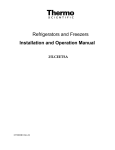
![MAPEAMENTO DE CONTROLE [CONTROLLER MAPPING]](http://vs1.manualzilla.com/store/data/006068957_1-5e2c8da72c516cb367b41ba39c141e7d-150x150.png)
